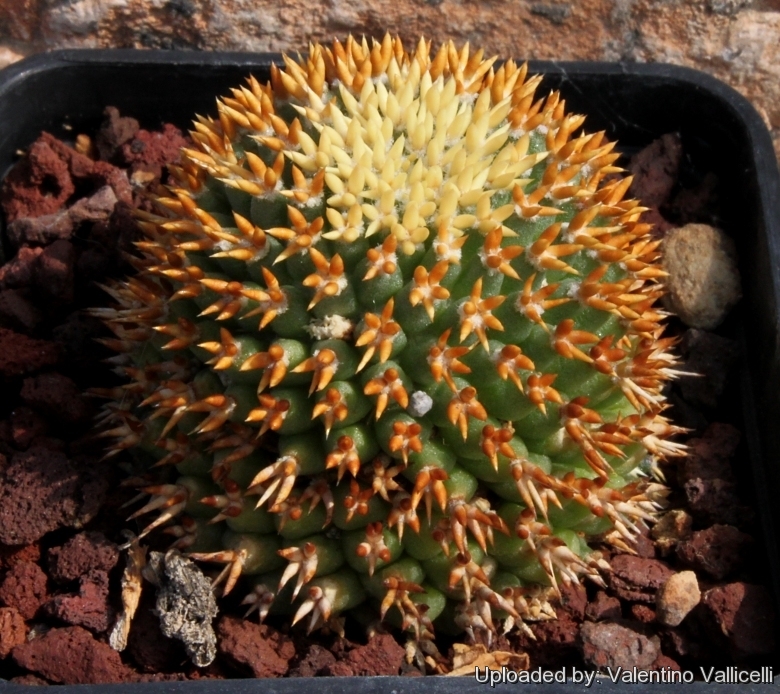
Mammillaria decipiens subs. camptotricha cv. Bru Photo by: Valentino Vallicelli
Very nice form with 4 to 5(-6) very short orangish radial spines. The younger spines are yellow and very attractive.
Origin and Habitat: Garden origin (Nursery produced cultivar).
The standard Mammillaria camptotrichaSN|14441]]SN|14441]] comes from the state of Queretaro, Mexico.Altitude 1.700 - 2.000 m.
Synonyms:
See all synonyms of Mammillaria decipiens
Common Names include:
ENGLISH: Short Spined Bird's Nest Mammillaria
Description: Mammillaria decipiens subs. camptotricha cv. Bru, also known as Mammillaria camptotricha f. brevispina or cv. Kotoito-maru (in Japanese speech), is an odd cultivars characterized by 4 short, orange, spindle-like, spines that form a cross. It unique-looking spination makes it on the the best mammillaria cultivars. The flowers are tiny yellowish-white but otherwise look like mammillaria flowers.
Habit: It is a small plant that make a large, flattish clump of stems clustering from the lower part.
Stem: Individual stems bout 4-7 cm in diameter, up to 10 cm tall, broadly globose to club shaped, depressed, deep-green.
Roots: Very large, tuberose.
Tubercles: Green, soft, flabby, cylindrical to obtuse about 2 cm long. Without latex. The axil is sparsely hairy with a few bristles.
Spines: Usually 4 (o more) not differentiated as central and radials, short, fat, spindel-like, at first yellowish white then straw yellow.
Flowers: Funnel-form, delicately scented, mall, white, deeply set in the tubercles, to about 1.5-1.8 cm long and wide. The outer petals of the flowers are greenish.
Fruits: Cylindrical, pale pink to greenish.
Seeds: Light brown.
Subspecies, varieties, forms and cultivars of plants belonging to the Mammillaria decipiens group
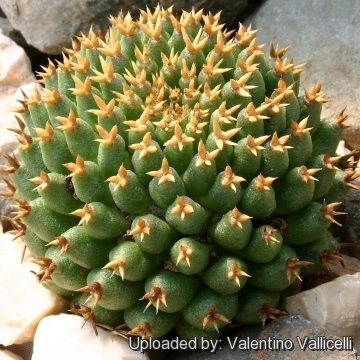 Mammillaria decipiens subs. camptotricha cv. Bru Photo by: Valentino Vallicelli
Mammillaria decipiens subs. camptotricha cv. Bru Photo by: Valentino Vallicelli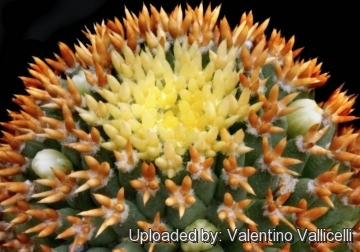 Mammillaria decipiens subs. camptotricha cv. Bru Photo by: Valentino Vallicelli
Mammillaria decipiens subs. camptotricha cv. Bru Photo by: Valentino Vallicelli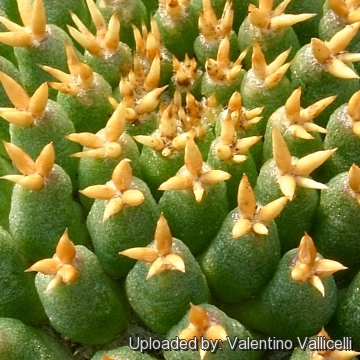 Mammillaria decipiens subs. camptotricha cv. Bru Photo by: Valentino Vallicelli
Mammillaria decipiens subs. camptotricha cv. Bru Photo by: Valentino Vallicelli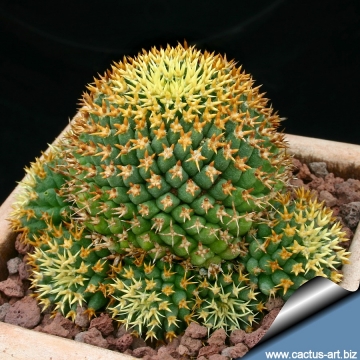 Mammillaria decipiens subs. camptotricha cv. Bru Photo by: Cactus Art
Mammillaria decipiens subs. camptotricha cv. Bru Photo by: Cactus Art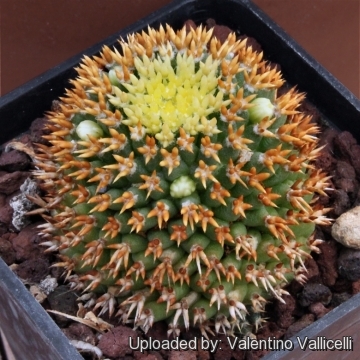 Mammillaria decipiens subs. camptotricha cv. Bru Photo by: Valentino Vallicelli
Mammillaria decipiens subs. camptotricha cv. Bru Photo by: Valentino Vallicelli Mammillaria decipiens subs. camptotricha cv. Bru Photo by: Cactus Art
Mammillaria decipiens subs. camptotricha cv. Bru Photo by: Cactus Art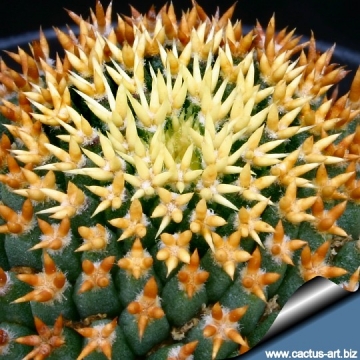 Mammillaria decipiens subs. camptotricha cv. Bru Photo by: Cactus Art
Mammillaria decipiens subs. camptotricha cv. Bru Photo by: Cactus Art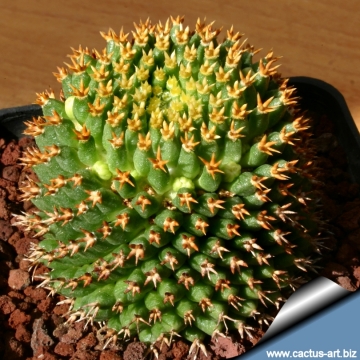 Mammillaria decipiens subs. camptotricha cv. Bru Photo by: Cactus Art
Mammillaria decipiens subs. camptotricha cv. Bru Photo by: Cactus ArtCultivation and Propagation: Mammillaria decipiens subs. camptotrichaSN|14439]]SN|14439]] cv. Bru is a freely clustering species that reproduces easily by cutting. It is a great starter plant for the cactus grower, that readily builds up into a dense cluster of stems. Does better than most species in lower levels of light, but still prefers bright light or morning sun.
Growth rate: Plants will offset readily, and dense clumps can be produced in a very few years.
Soils: It likes very porous mineral substratum and avoid the use of peat or other humus sources in the potting mixture.
Repotting: Repotting every 2-3 years, , or sooner if the roots get crowded. . As it is prone to rot under-pot in a smaller container filled with very porous compost. Use pot with good drainage.
Watering: Water regularly in summer, but do not overwater (very wet-sensitively, especially in light of its succulent root system). Its roots are easily lost in pots that stay damp for any length of time. Keep dry with ample airflow in winter. In the rest period no high atmospheric humidity!! Care must be taken with watering as they tends to become swollen and untidy in growth habit if given too much water and shade.
Fertilization: During the growing season enrich the soil using a fertilizer rich in potassium and phosphorous, but poor in nitrogen, because this chemical element doesn’t help the development of succulent plants, making them too soft and full of water.
Hardiness: It is quite frost resistant if kept dry, hardy as low as -5° C (some reports give it hardy to -7°C). However some warmth throughout the year will increase the grower's success (minimum 5° to 8°C during rest season). A resting period in winter and strong light are necessary so that it can flower properly.
Exposition: Outside filtered sunlight or afternoon shade, inside it needs bright light, and some direct sun. Subject to sunburn if exposed to direct sun for too long. Does better than most species in lower levels of light, but still prefers bright light or morning sun.
Uses: It is an excellent plant for container growing. It always looks good and stays small. It look fine in a cold greenhouse and frame.
Pests & diseases: It may be attractive to a variety of insects, but plants in good condition should be nearly pest-free, particularly if they are grown in a mineral potting-mix, with good exposure and ventilation. Nonetheless, there are several pests to watch for:
- Red spiders: Sensitive to red spider mite. Overhead watering is helpful in controlling mites.
- Mealy bugs: Occasionally mealy bugs they develop aerial into the new growth among the wool with disfiguring results, but the worst types develop underground on the roots and are invisible except by their effects.
- Scales: Scales are rarely a problem.
- Rot: Rot it is only a minor problem with cacti if the plants are watered and “aired” correctly. If they are not, fungicides won't help all that much.
Propagation: Cuttings or grafting. Wait until the offsets that appear at the base of old clustered specimens are 1/3 the size of the parent and then detach and plant. Cuttings will take root in a minimum temperature of 20° C (but better in hot weather). Cuttings of healthy shoots can be taken in the spring and summer. Cut the stem with a sharp, sterile knife, leave the cutting in a warm, dry place for a week or weeks (depending on how thick the cutting is) until a callus forms over the wound. Once the callus forms, the cutting may be inserted in a container filled with firmed cactus potting mix topped with a surface layer of coarse grit. They should be placed in the coarse grit only; this prevents the cut end from becoming too wet and allows the roots to penetrate the rich compost underneath. The cuttings should root in 2 to 6 weeks.



















